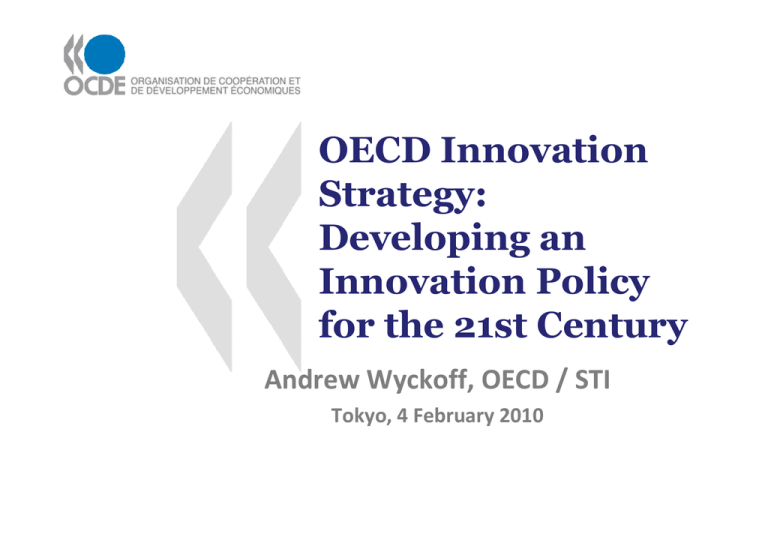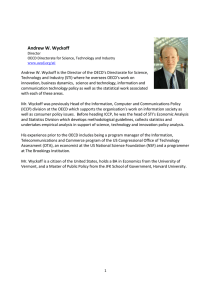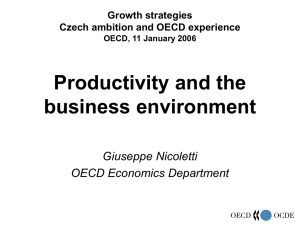OECD Innovation Strategy: Developing an Innovation Policy
advertisement

OECD Innovation Strategy: Developing an Innovation Policy for the 21st Century Andrew Wyckoff, OECD / STI Tokyo, 4 February 2010 Overview 1. The OECD Innovation Strategy 2. The innovation imperative 3. The changing nature of innovation 4. The Key Policy Messages from the OECD Innovation Strategy 5. Concluding remarks 2 1. OECD’s Innovation Strategy 3 The OECD Innovation Strategy: Cutting across many policy areas Competition Statistics Public governance 4 2. The Innovation Imperative 5 Innovation is a driver of growth... Innovation accounts for a large share of GDP growth Percentage contributions, 1995-2006, in % 5 4 Intangible capital 3 MFP 2 Non‐ICT capital 1 ICT capital 0 Capital ‐1 Labour quality 6 * Investment in intangibles and MFP account for between 2/3s and 3/4s of GDP growth. ...and is needed to restore lagging productivity growth... 7 ...and can help address global challenges like climate change. Potential technological contributions to CO2 emission reductions 70 CCS industry and transformation (9%) Baseline emissions 62 Gt Emissions (Gt CO2) 60 CCS power generation (10%) Nuclear (6%) 50 Renewables (21%) 40 Power generation efficiency and fuel switching (7%) 30 End use fuel switching (11%) 20 End use electricity efficiency (12%) BLUE Map emissions 14 Gt End use fuel efficiency (24%) 10 0 2005 WEO 2007 450 ppm case 2010 2015 2020 ETP2008 analysis 2025 2030 2035 2040 2045 2050 8 Note: WEO refers to the IEA’s 2007 World Energy Outlook. Source: International Energy Agency, Energy Technology Perspectives 2008: Scenarios and Strategies to 2050. 3. The Changing Nature of Innovation: the what, how, where & who have changed 9 What innovation encompasses has changed… • Broader than just R&D to include nonR&D innovation like design, marketing, organisational innovation; • Involves more than just “high-tech” firms; • Encompasses services, including nonmarket services like public sector services; 10 Innovation is not only about R&D... New to market product innovators with and without R&D, 2004‐06 (or latest) As a percentage of innovators Innovation (no R&D) In-house R&D 70% 60% 50% 40% 30% 20% 10% 0% 11 …and R&D is not only for hightech firms... Share of business R&D by technological intensity (manufacturing, 2006) 12 % Singapore Spain Luxembourg Slovak Republic Norway Finland Austria Czech Republic Ireland United Kingdom Poland Netherlands Brazil Germany Sweden Belgium Portugal Denmark France Greece Canada India United States Hungary Australia Italia Russian Federation Israel Switzerland South Africa Mexico New Zealand Hong Kong Turkey China Iceland Chinese Taipei Japan Korea ...and innovation is not only about manufacturing. Share of all trademarks registered by services 2008 1998 80 70 60 50 40 30 20 10 0 Policy Implications from the broadening of innovation • Growing importance of education and training: hard and soft skills, including entrepreneurship • Need to motivate and provide space for innovation to flourish: o Competition & empowering consumers o Solid, predictable institutional framework that supports entrepreneurs: • Recognition that a bundle of investments are 14 needed for innovation: tech & non-tech. How innovation is conducted has changed… • Increasingly at the intersection / interaction of separate borders: disciplines; geography and institutions • Cost pressures, competition and desire to reduce risk have led to more open / collaborative strategies; • Premium and competitive advantage attached to tacit knowledge: know-how, organisational capital, access to networks. 15 There is more collaboration among scientists... Trends in co-authorship in scientific publications Domestic co-authors Domestic single authors International coauthors International Single author 16 ...and between firms... Companies collaborating on innovation, as a percentage of all firms, 2004-2006 17 Source: OECD OECD,based basedon onEurostat, CIS and CIS-2006 national sources. (April 2009) and national data sources. …who are employing “open innovation” strategies for competitive advantage... Q3 ‘09 – Items shipped on behalf of sellers who utilized Fulfillment by Amazon (FBA): 3x from 2008 – Amazon Web Services (AWS): 300k users Q3 ‘09 – 100k approved apps, up from 65k in August – estimated 2.5b$US iPhone “apps economy”* 18 * www.gigaom.com 27/08/09 “How Big is the iPhone App Economy?” …aided by ICT (especially the Internet). 19 19 Policy Implications for a more open mode of innovation • Erect bridges between the different parts, forming or joining a network – not necessarily more or new hard infrastructure. • Soft skills are needed that can traverse disciplines, cultures and organisations. • Building networks through labour mobility. • Use of ICT to build networks; informatics as a multidisciplinary field and public depositories of information as a platform for innovation; • 20 Developing knowledge networks and markets; Where innovation occurs has changed… • MNEs still play a huge role; but increasingly more than just “D” abroad; • Young firms a key as change agents; • Increase in cross-border links; • Rise of China and India. 21 …with MNEs playing a large role… ...but so do young firms. Patent applications filed by young firms, 2005 As a percentage of patents filed by firms at the European Patent Office (EPO) % 25 Share of patents f iled by f irms under 5 years old 20 15 10 5 Netherlands Italy Germany France Belgium Finland Spain Austria United Kingdom Sweden Norway Denmark 0 Source: OECD, HAN database, October 2009 and Bureau Van Dijk Electronic Publishing, August 2008 23 Global innovation networks are emerging... 24 ...that alter relative comparative advantages... The Apple iPod = 299$ of Chinese exports to US Distribution of the value added • 299 US$ – 75$ profit to US (Apple) – 73$ whls/retail US (Apple) – 75$ to Japan (Toshiba) – 60$ 400 parts from Asia – 15$ 16 parts from the US – 2$ assembly by China • iTunes Music Store (2003) – 70% digital market share – Big 5 recording companies 25 http://blogs.computerworld.com/node/5724 …driven by new players... Contributions to growth in global R&D (in billion constant US PPP and %) 180 1996-2001 160 12% 2001-2006 140 11% 13% 120 10% 100 80 7% 23% 60 40 37% 20 Other non‐OECD (2) 30% China Other OECD (1) 13% Japan 13% EU‐27 15% United States 16% 0 1996‐2001 2001‐2006 Note: (1) Australia, Canada, Iceland, Korea, Mexico, New Zealand, Norway and Turkey (2) Argentina, Brazil, India, Israel, Russian Federation, Singapore, South Africa, Chinese Taipei Source: OECD. 26 ...that alter the topography of innovation. Broad based Leaders Narrow Leaders / Adopters Adopters / Followers link 27 Policy Implications of global networks of innovation • Build absorptive capacity: skills, institutions, access to networks; • Importance of services as a means of capturing value locally & gaining access to lead-users; • Universities are an essential node in innovation systems that can be the glue between actors, a local anchor into global networks and a magnet for global talent. • Building on existing strengths for dynamic comparative advantage through innovation. 28 Who the actors are in the innovation system has changed… 29 ...to include a wide range of actors... 30 …a range of Ministries... Finland’s Governance of Innovation Policy 31 …and many levels of government. 32 …which raises issues of how to govern policies for innovation. • Need for strong political leadership; • Need to clearly delineate local, regional & national roles to avoid duplication, and build coherence. • Need for measurement and evaluation frameworks to support policy. 33 4. Key Policy Messages 34 A) Adapting to a post crisis environment • Diffusing, applying, adapting vs. developing – the need for cooperation is growing. • Leverage public resources – partnerships with firms, avoid duplication. • Create room for new firms and allow creative destruction to occur . 35 B) Harness innovation to address global challenges • combination of “getting prices right” and stimulating innovation; stable and long-term policy horizon; improved international S&T co-operation; New mechanisms and platforms for collaboration based on new partnerships Enabling new actors: social entrepreneurship, foundations, etc. • Demand and supply side policies 36 C) Developing a more systemic set of policies for innovations – Most public policy is aimed at the creation of knowledge: R&D, HRST, IPR. – Need to better join up “push” and “pull” policies: • Empowering people to create knowledge and apply knowledge • Protecting IPR and creating value from IPR • Getting prices right to create markets for environmental innovation and policies that can create radical innovations and breakthroughs 37 4. Concluding Remarks: the Japanese Context 38 Challenges for Japan • People: – Little labour mobility within the economy and internationally – A dual labour market – Limited foreign interaction • Innovation in firms: – Very low degree of internationalisation – low FDI, and low degree of international cooperation in innovation – Relatively poor productivity growth in the services sector – some sectors remain too heavily regulated – Starting a business in Japan remains too complicated 39 Building on Japanese Strengths • Exploiting high Public & Private R&D • Improve the linkages between public & private • Enhance competition for R&D awards • Use strong base to tap into global networks • Global challenges: • Leverage strength in “green” innovation thru push and pull (getting prices right) • Assert leadership in multilateral STI co-operation for Grand Challenges • Apply ICT • • For services productivity, especially services for the aged. Seize on the shift to mobile computing. 40 Contact • E-mail comments & ideas: – Andrew.Wyckoff@oecd.org • Keep abreast – www.oecd.org/innovation/strategy 41





